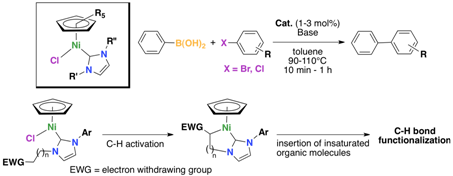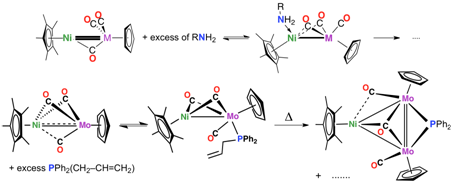University of Strasbourg and CNRS (UMR 7509) |
Research Areas |
Our research lies at the frontier of synthetic organic, inorganic and organometallic chemistry as well as of homogeneous and heterogeneous catalysis. With the aim of discovering environmentally and economically acceptable processes, we are particularly interested in making or breaking C–C, C-X (X = Cl, Br) or C–Y bonds (Y = H, N, O, P) within the coordination sphere of mono- or bimetallic transition metal organometallic complexes. Some of our current projects are listed below. |
Heterobimetallic complexes |



Novel NHC-nickel (II) complexes are synthesized and studied for the development of cheap, air stable and efficient catalysts. Target reactions include C–C cross-coupling reactions such as the Suzuki coupling and C–H bond functionalization reactions. Heterogenization of these compounds onto inorganic solid supports for the generation of effective, non-polluting, and truly recyclable catalysts is also targeted. |
Laboratoire de Chimie Organométallique Appliquée - LCOA |
Cooperativity between the metals often leads to new unexpected products not seen in mono-metallic or even in homo-polymetallic systems. For instance, we have recently evidenced the first structurally characterized nickel-primary amine organometallic complexes. In contrast, other two-electron donor ligands, such as PPh2(CH2–CH=CH2), coordinate to the group 6 metal, to give novel complexes with which activation of the P-C bond can be observed. |
Nickel(II) complexes bearing N-Heterocyclic Carbene (NHC) ligands for homogeneous catalysis |
Metallation of calixarenes |
Metallation of functionalized calixarenes with homo- or heterobimetallic systems is explored for the development of intra-cavity reactions. Control of the selectivity by the size/shape of the cavity is expected. |
Home Page | Research | Publication&Patents | Members | Collaborations | Teaching | Photos | Lab equipment |


